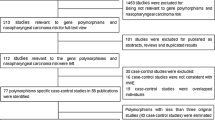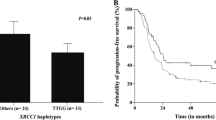Abstract
Tumor suppressor p53 is a critical player in the fight against cancer as it controls the cell cycle check point, apoptotic pathways and genomic stability. It is known to be the most frequently mutated gene in a wide variety of human cancers. Single-nucleotide polymorphism of p53 at codon72 leading to substitution of proline (Pro) in place of arginine (Arg) has been identified as a risk factor for development of many cancers, including nasopharyngeal carcinoma (NPC). However, the association of this polymorphism with NPC across the published literature has shown conflicting results. We aimed to conduct a case–control study for a possible relation of p53 codon72 Arg>Pro polymorphism with NPC risk in underdeveloped states of India, combine the result with previously available records from different databases and perform a meta-analysis to draw a more definitive conclusion. A total of 70 NPC patients and 70 healthy controls were enrolled from different hospitals of north-eastern India. The p53 codon72 Arg>Pro polymorphism was typed by polymerase chain reaction, which showed an association with NPC risk. In the meta-analysis consisting of 1842 cases and 2330 controls, it was found that individuals carrying the Pro allele and the ProPro genotype were at a significantly higher risk for NPC as compared with those with the Arg allele and the ArgArg genotype, respectively. Individuals with a ProPro genotype and a combined Pro genotype (ProPro+ArgPro) also showed a significantly higher risk for NPC over a wild homozygote ArgArg genotype. Additionally, the strength of each study was tested by power analysis and genotype distribution by Hardy–Weinberg equilibrium. The outcome of the study indicated that both allele frequency and genotype distribution of p53 codon72 Arg>Pro polymorphism were significantly associated with NPC risk. Stratified analyses based on ethnicity and source of samples supported the above result.
Similar content being viewed by others
Introduction
Nasopharyngeal carcinoma (NPC) arises from the epithelial cells that cover the upper part of the throat behind the nose and near the base of the skull. The disease is treatable at an early stage but the majority of NPC patients are diagnosed at a late stage because of the exhibition of nonspecific symptoms related to other head and neck illnesses.1, 2 General symptoms of NPC include trismus, otitis media, hearing loss, nasal regurgitation, cranial nerve palsies, nasal twang, bleeding and pain.3 The World Health Organization histopathological grading system classifies NPC into three types: keratinizing squamous cell carcinoma; non-keratinizing differentiated carcinoma; and undifferentiated carcinoma.4 The American joint committee on cancer established tumor, node and metastasis classification to determine the different stages of NPC.
Epidemiological studies suggest the association of food habits (alcohol, intake of salted fish containing nitrosamine, herbal tea and herbal medicine), lifestyle (occupational exposure to formaldehyde, chlorophenol, wood dust, tobacco users) and viral infection (Epstein–Barr virus and human papilloma virus) in the etiology of NPC.5, 6, 7, 8, 9 However, many individuals exposed to these parameters do not develop NPC, which indicates the involvement of genetic factors. To establish a link between genetic factors and NPC development, study of single-nucleotide polymorphism (SNP) in tumor suppressor genes has been the focus of many researchers.
p53 is a well-established tumor suppressor gene located on chromosome 17p13.1. It plays a critical role in response to genotoxic stress and tries to maintain genomic stability and control proper execution of the cell cycle and apoptotic pathways.10, 11, 12 Deregulated function of p53 may result in loss of this regulation, resulting in uncontrolled cell proliferation and cancer development.13, 14, 15 Polymorphisms in p53 or target genes impair the function of the p53 signaling pathway.16 The most studied polymorphism in p53 is located in exon 4 at codon72. It carries either the CGC sequence that encodes arginine or the CCC sequence that encodes proline due to G/C transversion.17, 18 As a result, two allelic forms (Arg and Pro) and three genotypes (ArgArg, ArgPro and ProPro) have evolved. These allelic variants and genotypes oscillate in their binding capacity to the transcriptional factors, induction of apoptosis and repression of transformation of human cells.7, 18, 19, 20 Arg variants induce apoptosis more efficiently than do the Pro variants, which may be due to their ability to localize into mitochondria and regulate the release of cytochrome C into cytosol.18 The released cytochrome C in turn activates caspase-3, one of the key executioners of apoptosis.21, 22 This difference between Arg and Pro variants may provide the plausible cause for Pro allele’s involvement in increased susceptibility to NPC. Earlier, several studies including our present study among the populations of north-eastern India have investigated the relation between p53 codon72 Arg>Pro polymorphism and NPC risk.23, 24, 25, 26, 27, 28, 34 In India, this rate is comparable to that of the United Kingdom with the younger age peak in the second decade.35, 36 Several susceptible genes have been implicated for NPC risk, such as tumor suppressor p53, TGFβ1, IL-12 p40 and DNA repair genes.28, Full size table
The p53 codon72 SNP has been studied by many groups across the world. In the Chinese population Birgander et al., in 1996, and Yung WC et al., in 1997 demonstrated no association between the mutant p53 codon72 and the risk for NPC.23 Subsequently, Tsai et al.,24 in 2002, reported that the p53 ProPro homozygote was a risk factor for NPC development. In the Thai population, Tiwawech et al.,25 in 2003, reported that the p53 gene polymorphism may be associated with NPC susceptibility, particularly the Pro/Pro genotype carriers in subjects older than 40 years. In Portugal, Sousa et al.26 in 2006 reported similar findings linking the susceptibility of the P53 codon72 polymorphism to NPC. Further, Hadhri-Guiga et al.,27 in 2007, found that individuals carrying the ProPro homozygote carried an elevated risk for NPC in Tunisia. Similarly, ** data with previous publications, and review articles.






